Attached files
| file | filename |
|---|---|
| 8-K - FORM 8-K - ARCH RESOURCES, INC. | c65749e8vk.htm |
Exhibit 99.1
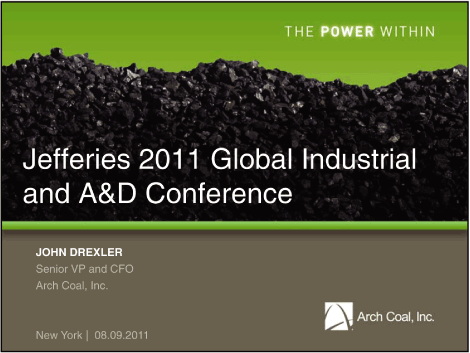
| Jefferies 2011 Global Industrial and A&D Conference JOHN DREXLER Senior VP and CFO Arch Coal, Inc. New York 08.09.2011 |
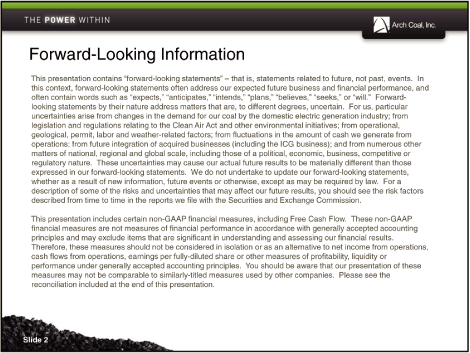
| Forward-Looking Information This presentation contains “forward-looking statements” — that is, statements related to future, not past, events. In this context, forward-looking statements often address our expected future business and financial performance, and often contain words such as “expects,” “anticipates,” “intends,” “plans,” “believes,” “seeks,” or “will.” Forward-looking statements by their nature address matters that are, to different degrees, uncertain. For us, particular uncertainties arise from changes in the demand for our coal by the domestic electric generation industry; from legislation and regulations relating to the Clean Air Act and other environmental initiatives; from operational, geological, permit, labor and weather-related factors; from fluctuations in the amount of cash we generate from operations; from future integration of acquired businesses (including the ICG business); and from numerous other matters of national, regional and global scale, including those of a political, economic, business, competitive or regulatory nature. These uncertainties may cause our actual future results to be materially different than those expressed in our forward-looking statements. We do not undertake to update our forward-looking statements, whether as a result of new information, future events or otherwise, except as may be required by law. For a description of some of the risks and uncertainties that may affect our future results, you should see the risk factors described from time to time in the reports we file with the Securities and Exchange Commission. This presentation includes certain non-GAAP financial measures, including Free Cash Flow. These non-GAAP financial measures are not measures of financial performance in accordance with generally accepted accounting principles and may exclude items that are significant in understanding and assessing our financial results. Therefore, these measures should not be considered in isolation or as an alternative to net income from operations, cash flows from operations, earnings per fully-diluted share or other measures of profitability, liquidity or performance under generally accepted accounting principles. You should be aware that our presentation of these measures may not be comparable to similarly-titled measures used by other companies. Please see the reconciliation included at the end of this presentation. |
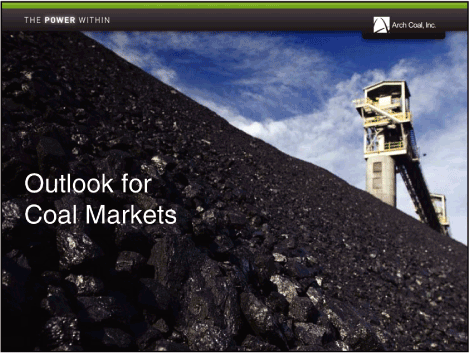
| Outlook for Coal Markets |
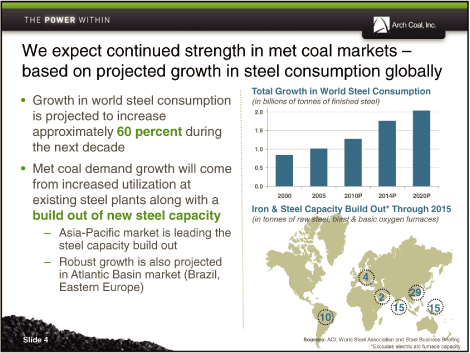
| We expect continued strength in met coal markets —based on projected growth in steel consumption globally Total Growth in World Steel Consumption • Growth in world steel consumption (in billions of tonnes of finished steel) is projected to increase 2.0 approximately 60 percent during 1.5 the next decade 1.0 • Met coal demand growth will come 0.5 from increased utilization at 0.0 existing steel plants along with a 2000 2005 2010P 2014P 2020P build out of new steel capacity Iron & Steel Capacity Build Out* Through 2015 (in tonnes of raw steel, blast & basic oxygen furnaces) — Asia-Pacific market is leading the steel capacity build out — Robust growth is also projected in Atlantic Basin market (Brazil, 4 Eastern Europe) 29 2 15 15 10 Slide 4 Sources: ACI, World Steel Association and Steel Business Briefing *Excludes electric arc furnace capacity |
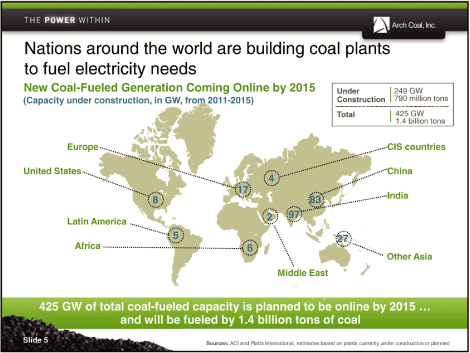
| Nations around the world are building coal plants to fuel electricity needs New Coal-Fueled Generation Coming Online by 2015 Under 249 GW (Capacity under construction, in GW, from 2011-2015) Construction 790 million tons Total 425 GW 1.4 billion tons Europe CIS countries United States China 4 17 8 83 India 2 97 Latin America 5 27 Africa 6 Other Asia Middle East 425 GW of total coal-fueled capacity is planned to be online by 2015 ... and will be fueled by 1.4 billion tons of coal Slide 5 Sources: ACI and Platts International, estimates based on plants currently under construction or planned |
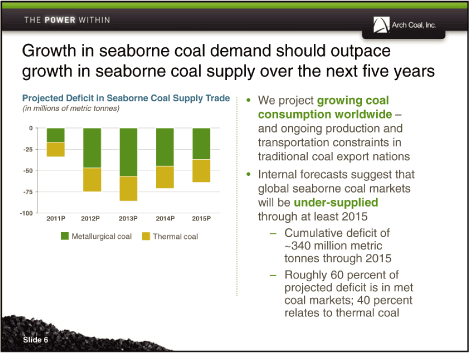
| Growth in seaborne coal demand should outpace growth in seaborne coal supply over the next five years Projected Deficit in Seaborne Coal Supply Trade • We project growing coal (in millions of metric tonnes) consumption worldwide — 0 and ongoing production and transportation constraints in -25 traditional coal export nations -50 • Internal forecasts suggest that -75 global seaborne coal markets will be under-supplied -100 through at least 2015 2011P 2012P 2013P 2014P 2015P Metallurgical coal Thermal coal — Cumulative deficit of ~340 million metric tonnes through 2015 — Roughly 60 percent of projected deficit is in met coal markets; 40 percent relates to thermal coal |
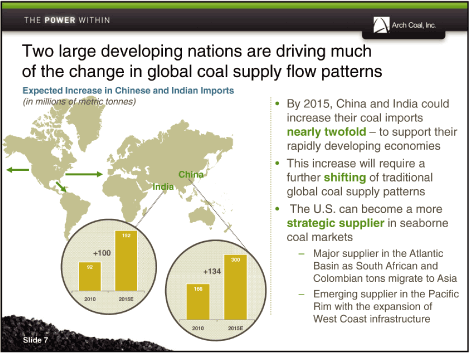
| Two large developing nations are driving much of the change in global coal supply flow patterns Expected Increase in Chinese and Indian Imports (in millions of metric tonnes) • By 2015, China and India could increase their coal imports nearly twofold — to support their rapidly developing economies • This increase will require a China further shifting of traditional India global coal supply patterns • The U.S. can become a more strategic supplier in seaborne 192 coal markets +100 — Major supplier in the Atlantic 300 92 +134 Basin as South African and Colombian tons migrate to Asia 166 — Emerging supplier in the Pacific 2010 2015E Rim with the expansion of West Coast infrastructure 2010 2015E Slide 7 |
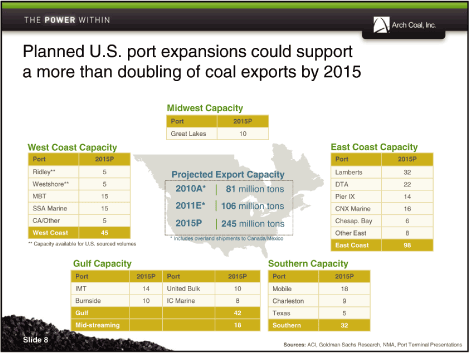
| Planned U.S. port expansions could support a more than doubling of coal exports by 2015 Midwest Capacity Port 2015P Great Lakes 10 West Coast Capacity East Coast Capacity Port 2015P Port 2015P Ridley** 5 Projected Export Capacity Lamberts 32 Westshore** 5 2010A* 81 million tons DTA 22 MBT 15 Pier IX 14 SSA Marine 15 2011E* 106 million tons CNX Marine 16 CA/Other 5 2015P 245 million tons Chesap. Bay 6 West Coast 45 Other East 8 * Includes overland shipments to Canada/Mexico ** Capacity available for U.S. sourced volumes East Coast 98 Gulf Capacity Southern Capacity Port 2015P Port 2015P Port 2015P IMT 14 United Bulk 10 Mobile 18 Burnside 10 IC Marine 8 Charleston 9 Gulf 42 Texas 5 Mid-streaming 18 Southern 32 Slide 8 Sources: ACI, Goldman Sachs Research, NMA, Port Terminal Presentations |
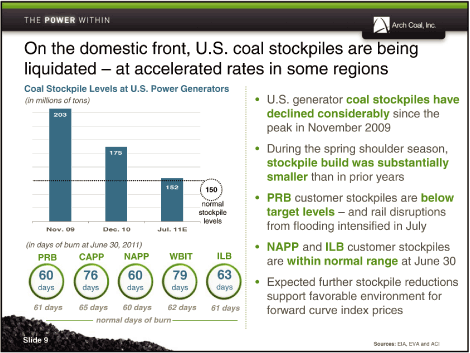
| On the domestic front, U.S. coal stockpiles are being liquidated — at accelerated rates in some regions Coal Stockpile Levels at U.S. Power Generators (in millions of tons) • U.S. generator coal stockpiles have 203 declined considerably since the peak in November 2009 175 • During the spring shoulder season, stockpile build was substantially smaller than in prior years 152 150 • PRB customer stockpiles are below normal stockpile target levels — and rail disruptions levels from flooding intensified in July Nov. 09 Dec. 10 Jul. 11E (in days of burn at June 30, 2011) • NAPP and ILB customer stockpiles PRB CAPP NAPP WBIT ILB are within normal range at June 30 60 76 60 79 63 days • Expected further stockpile reductions days days days days support favorable environment for 61 days 65 days 60 days 62 days 61 days forward curve index prices normal days of burn Slide 9 Sources: EIA, EVA and ACI |
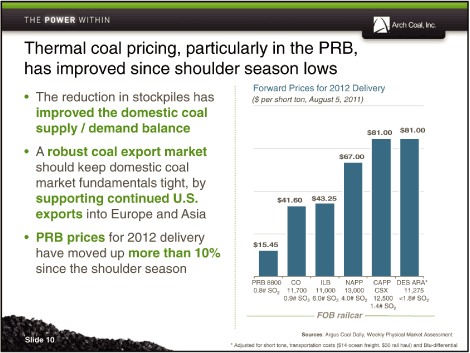
| Thermal coal pricing, particularly in the PRB, has improved since shoulder season lows Forward Prices for 2012 Delivery • The reduction in stockpiles has ($ per short ton, August 5, 2011) improved the domestic coal supply / demand balance $81.00 $81.00 • A robust coal export market $67.00 should keep domestic coal market fundamentals tight, by supporting continued U.S. $41.60 $43.25 exports into Europe and Asia • PRB prices for 2012 delivery $15.45 have moved up more than 10% since the shoulder season PRB 8800 CO ILB NAPP CAPP DES ARA* 0.8# SO2 11,700 11,000 13,000 CSX 11,275 0.9# SO2 6.0# SO2 4.0# SO2 12,500 <1.8# SO2 1.4# SO2 FOB railcar Sources: Argus Coal Daily, Weekly Physical Market Assessment Slide 10 * Adjusted for short tons, transportation costs ($14 ocean freight, $30 rail haul) and Btu-differential |
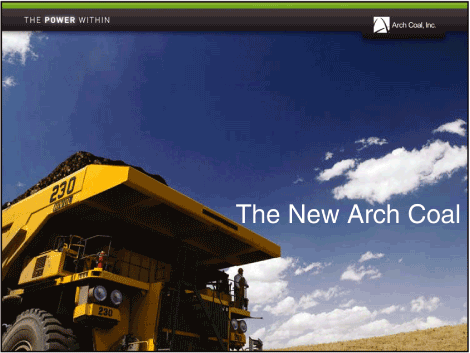
| The New Arch Coal Slide 11 |
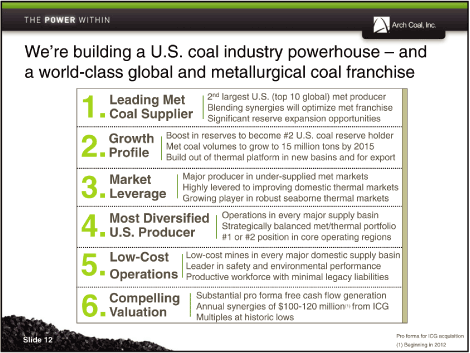
| We’re building a U.S. coal industry powerhouse — and a world-class global and metallurgical coal franchise Leading Met 2nd largest U.S. (top 10 global) met producer 1. Coal Supplier Blending synergies will optimize met franchise Significant reserve expansion opportunities Growth Boost in reserves to become #2 U.S. coal reserve holder 2. Profile Met coal volumes to grow to 15 million tons by 2015 Build out of thermal platform in new basins and for export Market Major producer in under-supplied met markets 3. Leverage Highly levered to improving domestic thermal markets Growing player in robust seaborne thermal markets Most Diversified Operations in every major supply basin 4. U.S. Producer Strategically balanced met/thermal portfolio #1 or #2 position in core operating regions Low-Cost Low-cost mines in every major domestic supply basin 5. Leader in safety and environmental performance Operations Productive workforce with minimal legacy liabilities Compelling Substantial pro forma free cash flow generation 6. Valuation Annual synergies of $100-120 million(1) from ICG Multiples at historic lows Slide 12 Pro forma for ICG acquisition (1) Beginning in 2012 |
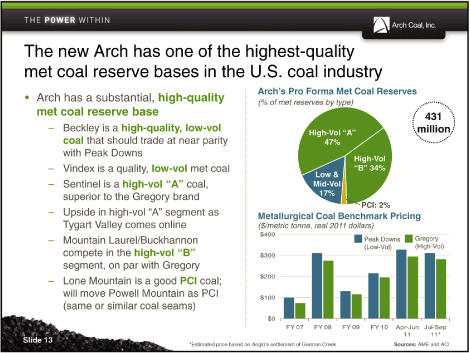
| The new Arch has one of the highest-quality met coal reserve bases in the U.S. coal industry • Arch has a substantial, high-quality Arch’s Pro Forma Met Coal Reserves (% of met reserves by type) met coal reserve base 431 — Beckley is a high-quality, low-vol million High-Vol “A” coal that should trade at near parity 47% with Peak Downs High-Vol — Vindex is a quality, low-vol met coal “B” 34% Low & — Sentinel is a high-vol “A” coal, Mid-Vol superior to the Gregory brand 17% PCI: 2% — Upside in high-vol “A” segment as Metallurgical Coal Benchmark Pricing Tygart Valley comes online ($/metric tonne, real 2011 dollars) $400 — Mountain Laurel/Buckhannon Peak Downs Gregory (Low-Vol) (High-Vol) compete in the high-vol “B” $300 segment, on par with Gregory — Lone Mountain is a good PCI coal; $200 will move Powell Mountain as PCI $100 (same or similar coal seams) $0 FY 07 FY 08 FY 09 FY 10 Apr-Jun Jul-Sep 11 11* Slide 13 *Estimated price based on Anglo’s settlement of German Creek Sources: AME and ACI |
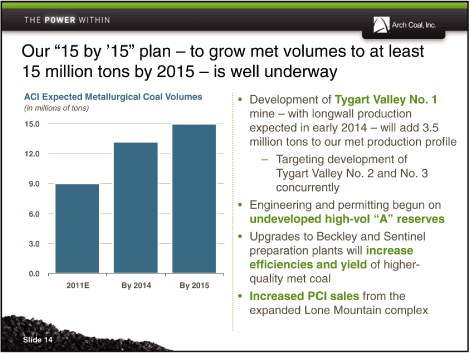
| Our “15 by ’15” plan — to grow met volumes to at least 15 million tons by 2015 — is well underway ACI Expected Metallurgical Coal Volumes • Development of Tygart Valley No. 1 (in millions of tons) mine — with longwall production 15.0 expected in early 2014 — will add 3.5 million tons to our met production profile 12.0 — Targeting development of Tygart Valley No. 2 and No. 3#2, #3 9.0 concurrently • Engineering and permitting begun on 6.0 undeveloped high-vol “A” reserves • Upgrades to Beckley and Sentinel 3.0 preparation plants will increase efficiencies and yield of higher- 0.0 quality met coal 2011E By 2014 By 2015 • Increased PCI sales from the expanded Lone Mountain complex Slide 14 |
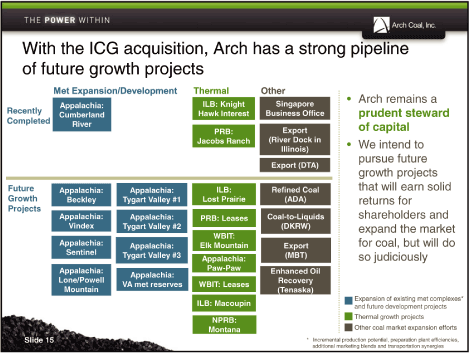
| With the ICG acquisition, Arch has a strong pipeline of future growth projects Other Singapore • Arch remains a Appalachia: ILB: Knight Recently Hawk Interest Business Office prudent steward Cumberland Completed River of capital PRB: Export Jacobs Ranch (River Dock in • We intend to Illinois) pursue future Export (DTA) growth projects Future Appalachia: Appalachia: ILB: Refined Coal that will earn solid Growth Beckley Tygart Valley #1 Lost Prairie (ADA) returns for Projects shareholders and Appalachia: Appalachia: PRB: Leases Coal-to-Liquids Vindex Tygart Valley #2 (DKRW) expand the market WBIT: Appalachia: Appalachia: Elk Mountain Export for coal, but will do Sentinel Tygart Valley #3 (MBT) so judiciously Appalachia: Appalachia: Paw-Paw Enhanced Oil Appalachia: Lone/Powell Recovery VA met reserves WBIT: Leases Mountain (Tenaska) Expansion of existing met complexes* ILB: Macoupin and future development projects NPRB: Thermal growth projects Montana Other coal market expansion efforts Slide 15 * Incremental production potential, preparation plant efficiencies, additional marketing blends and transportation synergies |
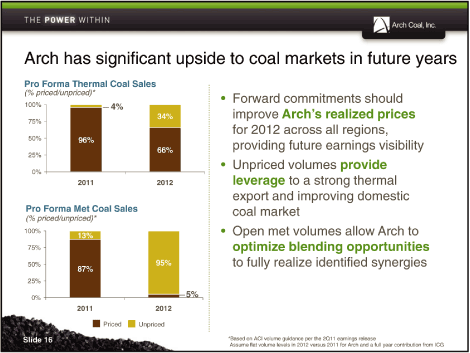
| Arch has significant upside to coal markets in future years Pro Forma Thermal Coal Sales (% priced/unpriced)* • Forward commitments should 100% 4% 34% improve Arch’s realized prices 75% for 2012 across all regions, 50% 96% providing future earnings visibility 66% 25% • Unpriced volumes provide 0% 2011 2012 leverage to a strong thermal export and improving domestic Pro Forma Met Coal Sales coal market (% priced/unpriced)* 100% • Open met volumes allow Arch to 13% 75% optimize blending opportunities 50% 95% to fully realize identified synergies 87% 25% 0% 5% 2011 2012 Priced Unpriced Slide 16 *Based on ACI volume guidance per the 2Q11 earnings release Assume flat volume levels in 2012 versus 2011 for Arch and a full year contribution from ICG |
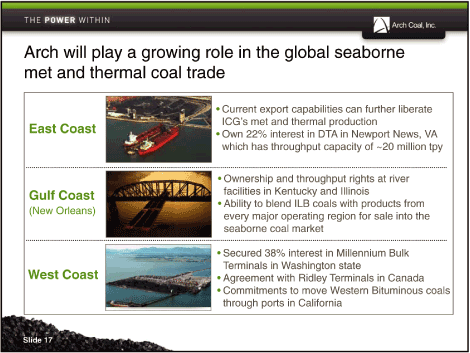
| Arch will play a growing role in the global seaborne met and thermal coal trade • Current export capabilities can further liberate ICG’s met and thermal production East Coast • Own 22% interest in DTA in Newport News, VA which has throughput capacity of ~20 million tpy • Ownership and throughput rights at river Gulf Coast facilities in Kentucky and Illinois • Ability to blend ILB coals with products from (New Orleans) every major operating region for sale into the seaborne coal market • Secured 38% interest in Millennium Bulk Terminals in Washington state West Coast • Agreement with Ridley Terminals in Canada • Commitments to move Western Bituminous coals through ports in California Slide 17 |
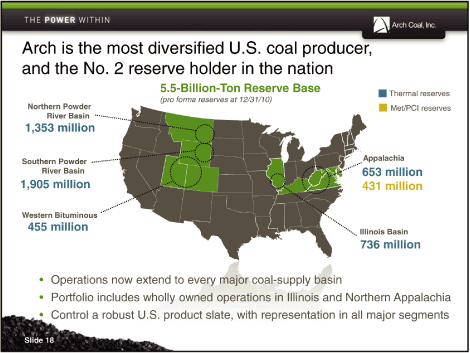
| Arch is the most diversified U.S. coal producer, and the No. 2 reserve holder in the nation 5.5-Billion-Ton Reserve Base Thermal reserves (pro forma reserves at 12/31/10) Northern Powder Met/PCI reserves River Basin 1,353 million Southern Powder Appalachia River Basin 653 million 1,905 million 431 million Western Bituminous 455 million Illinois Basin 736 million • Operations now extend to every major coal-supply basin • Portfolio includes wholly owned operations in Illinois and Northern Appalachia • Control a robust U.S. product slate, with representation in all major segments Slide 18 |
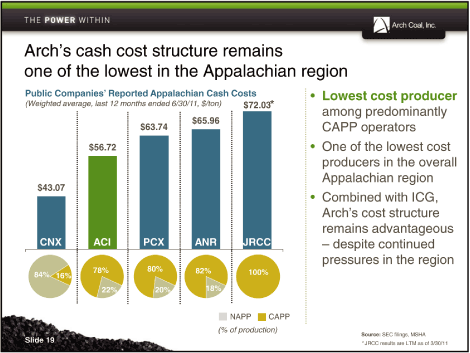
| Arch’s cash cost structure remains one of the lowest in the Appalachian region Public Companies’ Reported Appalachian Cash Costs • Lowest cost producer (Weighted average, last 12 months ended 6/30/11, $/ton) $72.03* among predominantly $65.96 $63.74 CAPP operators $56.72 • One of the lowest cost producers in the overall Appalachian region $43.07 • Combined with ICG, Arch’s cost structure remains advantageous CNX ACI PCX ANR JRCC — despite continued CNX ACI* PCX ANR* JRCC pressures in the region 78% 80% 82% 100% 84% 16% 22% 20% 18% NAPP CAPP (% of production) Source: SEC filings, MSHA Slide 19 * JRCC results are LTM as of 3/30/11 |
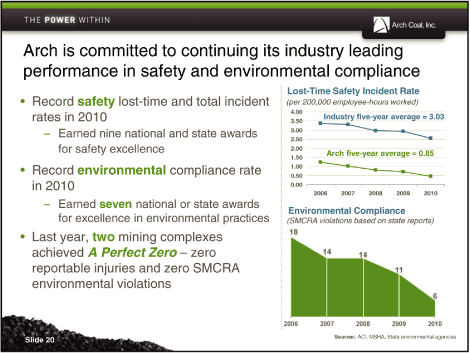
| Arch is committed to continuing its industry leading performance in safety and environmental compliance Lost-Time Safety Incident Rate • Record safety lost-time and total incident (per 200,000 employee-hours worked) 4.00 rates in 2010 Industry five-year average = 3.03 3.50 — Earned nine national and state awards 3.00 2.50 for safety excellence 2.00 Arch five-year average = 0.85 1.50 • Record environmental compliance rate 1.00 0.50 in 2010 0.00 2006 2007 2008 2009 2010 — Earned seven national or state awards Environmental Compliance for excellence in environmental practices (SMCRA violations based on state reports) • Last year, two mining complexes achieved A Perfect Zero — zero reportable injuries and zero SMCRA environmental violations Slide 20 Sources: ACI, MSHA, State environmental agencies |
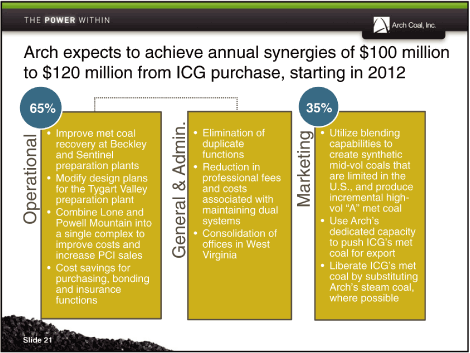
| Arch expects to achieve annual synergies of $100 million to $120 million from ICG purchase, starting in 2012 65% 35% . • Improve met coal Admin • Elimination of Marketing • Utilize blending Operational recovery at Beckley duplicate capabilities to and Sentinel functions create synthetic preparation plants • Reduction in mid-vol coals that • Modify design plans professional fees are limited in the for the Tygart Valley & and costs U.S., and produce preparation plant associated with incremental high-General vol “A” met coal • Combine Lone and maintaining dual Powell Mountain into systems • Use Arch’s a single complex to • Consolidation of dedicated capacity improve costs and offices in West to push ICG’s met increase PCI sales Virginia coal for export • Cost savings for • Liberate ICG’s met purchasing, bonding coal by substituting and insurance Arch’s steam coal, functions where possible Slide 21 |
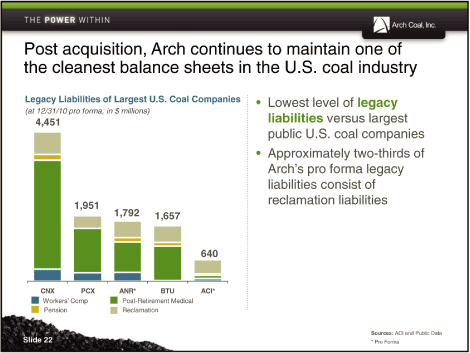
| Post acquisition, Arch continues to maintain one of the cleanest balance sheets in the U.S. coal industry Legacy Liabilities of Largest U.S. Coal Companies • Lowest level of legacy (at 12/31/10 pro forma, in $ millions) liabilities versus largest 4,451 public U.S. coal companies • Approximately two-thirds of Arch’s pro forma legacy liabilities consist of 1,951 reclamation liabilities 1,792 1,657 640 CNX PCX ANR* BTU ACI* Workers’ Comp Post-Retirement Medical Pension Reclamation Sources: ACI and Public Data Slide 22 * Pro Forma |
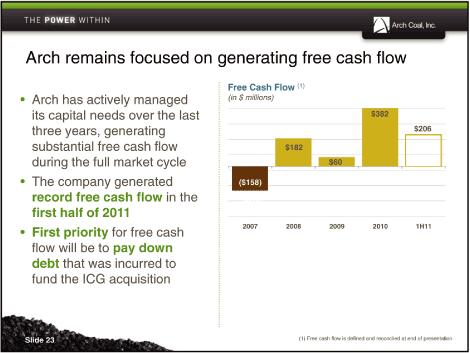
| Arch remains focused on generating free cash flow Free Cash Flow (1) • Arch has actively managed (in $ millions) its capital needs over the last $382 three years, generating $206 substantial free cash flow $182 during the full market cycle $60 • The company generated ($158) record free cash flow in the ($315) first half of 2011 • First priority for free cash 2007 2008 2009 2010 1H11 flow will be to pay down debt that was incurred to fund the ICG acquisition Slide 23 (1) Free cash flow is defined and reconciled at end of presentation |
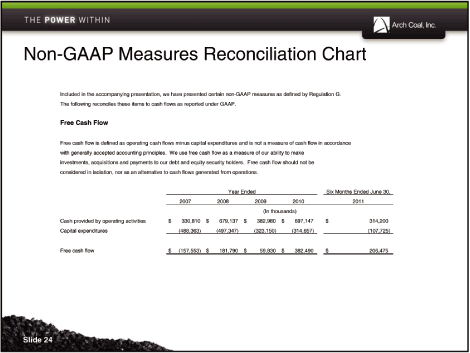
| Non-GAAP Measures Reconciliation Chart Included in the accompanying presentation, we have presented certain non-GAAP measures as defined by Regulation G. The following reconciles these items to cash flows as reported under GAAP. Free Cash Flow Free cash flow is defined as operating cash flows minus capital expenditures and is not a measure of cash flow in accordance with generally accepted accounting principles. We use free cash flow as a measure of our ability to make investments, acquisitions and payments to our debt and equity security holders. Free cash flow should not be considered in isolation, nor as an alternative to cash flows generated from operations. Year Ended Six Months Ended June 30, 2007 2008 2009 2010 2011 (In thousands) Cash provided by operating activities $330,810 $679,137 $382,980 $697,147 $314,200 Capital expenditures (488,363) (497,347) (323,150) (314,657) (107,725) Free cash flow $ (157,553) $181,790 $59,830 $382,490 $206,475 |
